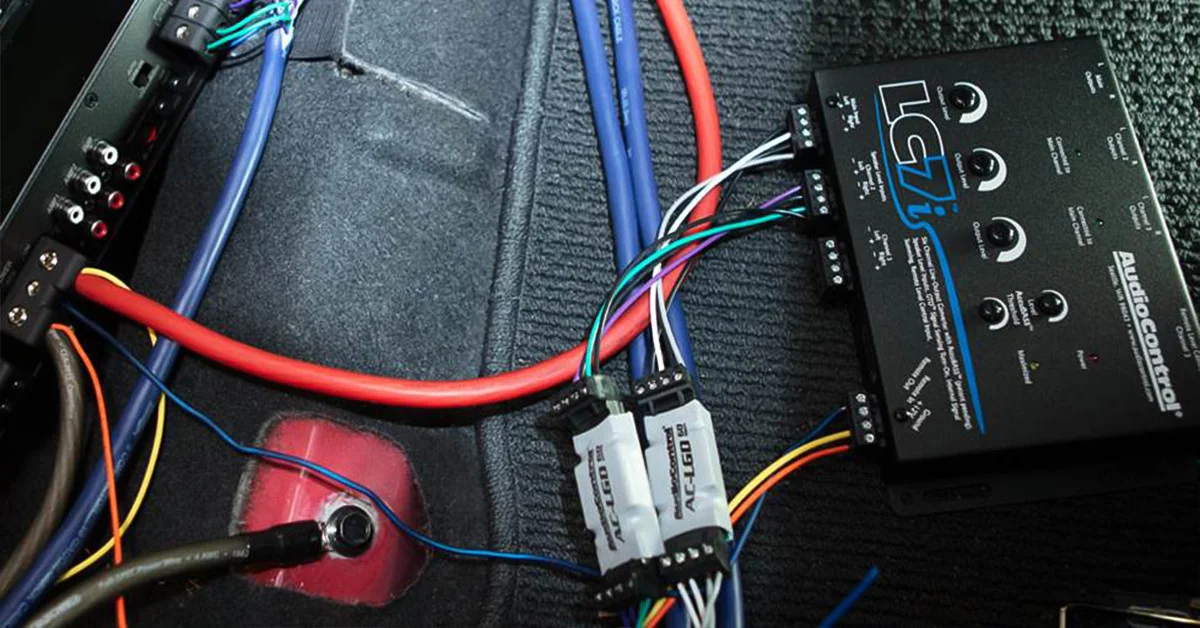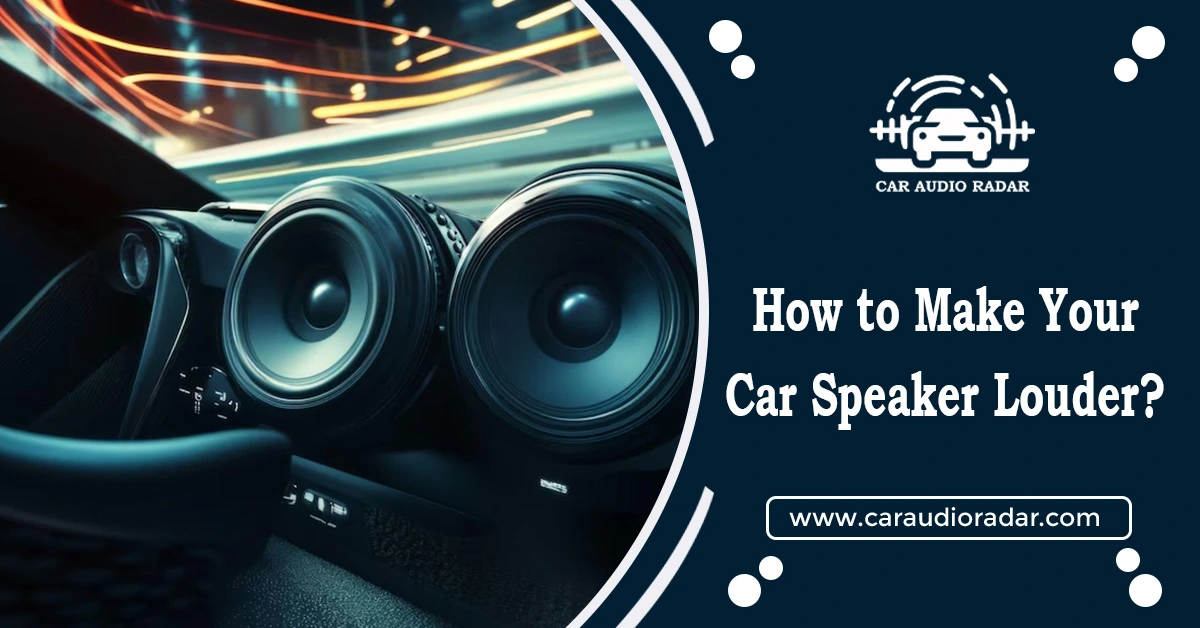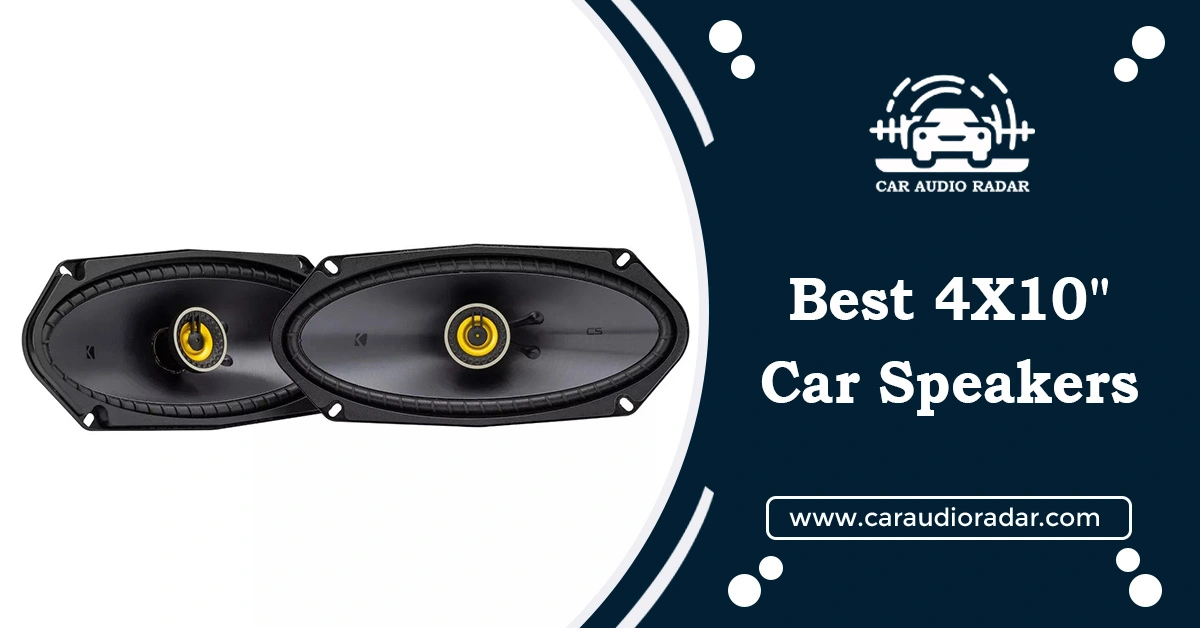
Jump to
Crossover in Car Audio – Do I Need One? Comprehensive Guide

Do I need a crossover in car audio? How do I choose a crossover ? Crossovers are electronic components designed to manage the distribution of audio signals. They ensure that different frequency ranges are directed to the appropriate speakers, optimizing audio quality.
What Is a Crossover Crossover in Car Audio, and What Does It Do?
Crossovers are essentially electronic devices in audio systems, transforming a single audio input signal into two or three distinct signals by segmenting them based on frequencies. Imagine it as a crossroads with three paths, where the crossover directs each band of frequencies to its designated destination.
Crossovers split the incoming audio signal into separate bands, allowing for individual treatment of low, mid, and high frequencies. By categorizing frequencies, crossovers ensure that each speaker receives the range it’s best equipped to handle. Picture a crossroads where the crossover acts as a sign, directing each frequency band down its designated path.
What Is a Frequency?
A frequency is the number of occurrences of a repeating event per unit of time. In the context of sound or audio, it refers to the rate at which a vibration, oscillation, or wave completes a cycle in a second. Measured in Hertz (Hz), one hertz represents one cycle per second.
Higher frequencies correspond to shorter wavelengths and, in the realm of audio, higher-pitched sounds. Understanding frequency is crucial in audio systems, as it allows for categorising different sound ranges and forms the basis for technologies like crossovers, which direct specific frequency bands to optimize audio output.
What Is a Crossover Frequency?
A crossover frequency is a specific point in the frequency spectrum where an audio signal is divided into different bands. In audio systems, especially speakers, a crossover frequency marks the boundary between low, mid, and high-frequency ranges.
Crossovers use filters to separate the incoming signal into these bands, directing each portion to the respective speaker designed to handle that frequency range. This precision ensures speakers operate within their optimal frequency range, preventing distortion and enhancing overall audio quality.
Selecting an appropriate crossover frequency is vital for achieving balanced and accurate sound reproduction in audio setups.
Recommended Crossover Frequencies
Recommended crossover frequencies vary based on the specific audio components and the speakers’ characteristics. However, here are general guidelines for familiar speaker setups:
Subwoofers
Low-pass crossover frequency: typically set between 80 Hz and 120Hz, directing low-frequency signals to the subwoofer for deep bass reproduction.
Midrange Speakers
High-pass crossover frequency: Ranges between 100 Hz and 300 Hz, allowing midrange speakers to handle frequencies above the set point.
Tweeters
Low-pass crossover frequency: Usually set above 3,000Hz, directing high-frequency signals to tweeters for clear and crisp reproduction.
These are general recommendations, and actual crossover frequencies may need adjustment based on the specific characteristics of the speakers and the room acoustics. It’s essential to refer to the manufacturer’s guidelines and experiment to find the optimal settings for your audio system.
Recommended Crossover Frequency Table
Here’s a recommended crossover frequency table for familiar speaker setups:
Subwoofers
Low-pass
80Hz – 120Hz
Midrange Speakers
High-pass
100Hz – 300Hz
Tweeters
Low-pass
Above 3,000Hz
How To Set Crossover Frequency For A Car Audio System
Setting the crossover frequency for a car audio system is crucial for achieving balanced and high-quality sound. Here’s a step-by-step guide:
- Identify the specifications of your car speakers, including their frequency response range. This information is usually available in the speaker’s manual or the manufacturer’s website.
- Car audio systems often have both high-pass and low-pass crossovers. High-pass filters allow higher frequencies to pass to smaller speakers like tweeters, while low-pass filters direct lower frequencies to more prominent speakers or subwoofers.
- Start by setting the high-pass crossover frequency for your tweeters and midrange speakers. This prevents them from reproducing low frequencies, and they may need help handling them. A typical starting point is 2,000Hz for tweeters, and adjusting from there based on the speaker specifications and personal preference.
- For subwoofers, set the low-pass crossover frequency to prevent them from attempting to reproduce high frequencies. A typical starting point is around 80Hz, and adjustments can be made based on the subwoofer’s capabilities and the overall system balance.
- Take into account the physical placement of your speakers within the car. Adjust crossover frequencies to compensate for any acoustic challenges posed by the interior.
- Most car audio systems allow you to adjust crossover frequencies through the head unit or an external signal processor. Refer to your car stereo’s manual for instructions on accessing and modifying crossover settings.
- Play music with a diverse range of frequencies to assess the impact of your crossover settings.
- Make minor adjustments to the crossover frequencies and observe how they affect the overall sound quality.
- Refer to the manuals or guidelines the speaker and car audio system manufacturers provided for specific recommendations.
- Take your car for a drive and listen to how the system performs in real-world conditions. Road noise and the car’s interior can influence sound, so adjust accordingly.
- If you find achieving the desired sound quality challenging, consider seeking assistance from a professional car audio installer. They can provide expert advice and optimize the system for your car’s acoustics.
Why Do The Speakers In Our Cars Need Crossovers?
Speakers in-car audio systems require crossovers for several important reasons to ensure optimal performance and audio quality:
Frequency Distribution
- Car audio systems typically consist of speakers, such as tweeters, midrange speakers, and subwoofers, each specialized in handling specific frequency ranges.
- Crossovers divide the audio signal into these distinct frequency units and direct them to the appropriate speakers. This prevents each speaker from attempting to reproduce frequencies outside its designed range.
Speaker Protection
- Crossovers act as a protective measure for speakers by preventing them from handling frequencies that could damage them.
- For example, sending deep bass frequencies to small tweeters can lead to distortion or damage. Crossovers ensure that each speaker receives frequencies it can effectively reproduce, enhancing longevity.
Clarity and Precision
- By directing specific frequency ranges to dedicated speakers, crossovers contribute to the clarity and precision of the audio output.
- Tweeters can handle high frequencies, midrange speakers cover the middle frequencies, and subwoofers reproduce the low frequencies. This specialization enhances the overall sound quality.
Customization of Sound
- Crossovers allow users to customize the sound output according to their preferences.
- Adjusting crossover frequencies allows users to fine-tune the balance between different frequency ranges, creating a personalized audio experience tailored to their liking.
Optimizing Speaker Efficiency
- Different speakers have varying efficiency levels at different frequencies. Crossovers ensure that each speaker operates within its most efficient range, maximizing overall system performance.
Preventing Interference
- With crossovers, speakers may refrain from interfering with each other, leading to chaotic and distorted sound.
- Crossovers eliminate interference by precisely directing frequencies to the speakers best suited for reproducing them.
Enhancing Overall System Performance
- By managing the distribution of frequencies, crossovers contribute to the overall performance of the car audio system.
- Properly configured crossovers result in a balanced and immersive listening experience, regardless of the type of music or audio content being played.
Types Of Crossover Frequencies For In-Car Audio
In-car audio systems employ different types of crossovers to manage the distribution of frequencies among various speakers. Here are the common types:
Electronic Crossover
- Description: Electronic crossovers split and direct specific frequency bands to different speakers using electronic circuitry.
- Functionality: They allow for precise control over crossover points and slopes, providing flexibility in tailoring the audio output to match speaker capabilities and the car’s acoustic environment.
- Advantages: Electronic crossovers offer versatility and often come with adjustable settings, making them suitable for fine-tuning vehicle audio systems.
Passive Crossover
- Description: Passive crossovers use passive components like resistors, capacitors, and inducers to divide the audio signal and distribute frequencies to the appropriate speakers.
- Functionality: These crossovers are more straightforward in design and do not require a power source. They are commonly found in factory-installed car audio systems.
- Advantages: Passive crossovers are cost-effective and easy to install, making them a practical choice for basic audio setups. However, they may have limitations in terms of customization.
Digital (Software-Based) Crossovers
- Description: Digital crossovers use digital signal processing (DSP) and software algorithms to manage crossover functions.
- Functionality: They offer advanced control and flexibility, allowing users to adjust crossover points, slopes, and other parameters through software interfaces.
- Advantages: Digital crossovers provide precise tuning and can be part of a broader digital signal processing system. They are often favoured in high-end car audio setups for their ability to optimize sound quality.
Other Types of Crossovers
Beyond electronic, passive, and digital crossovers, additional types cater to specific audio system needs and preferences. Here are three other notable types:
Component Crossovers
- Description: Component crossovers, also known as “active crossovers,” are standalone devices that separate and direct specific frequency bands to individual speakers. Unlike built-in crossovers, component crossovers are external units.
- Functionality: They offer precise control over crossover points and slopes, allowing users to customize the audio output for each speaker independently.
- Advantages: Component crossovers provide speaker selection and placement flexibility, making them popular in high-performance audio setups where tailored tuning is crucial.
Hybrid Crossovers
- Description: Hybrid crossovers combine elements of both active and passive crossovers. They often incorporate analogue circuitry for simplicity and digital signal processing (DSP) for advanced tuning capabilities.
- Functionality: Hybrid crossovers aim to provide the best of both worlds, offering the efficiency and simplicity of passive crossovers and active crossovers’ customisation options.
- Advantages: These versatile crossovers allow users to enjoy the benefits of analogue and digital technologies. They can be suitable for those seeking a balanced and adaptable solution.
Essential Ways to "Crossover" or Divide Frequencies
Dividing frequencies in an audio system involves using filters to direct specific frequency ranges to designated speakers. Here are three basic ways to achieve this crossover effect:
High-Pass Filter
- Functionality: A high-pass filter allows frequencies above a certain point to pass through while attenuating or blocking frequencies below that point.
- Application: High-pass filters are commonly used to direct higher-frequency signals to appropriate speakers, such as midrange or tweeter frequencies. They prevent low frequencies from reaching speakers ill-equipped to handle them, optimizing audio clarity and preventing distortion.
Low-Pass Filter
- Functionality: A low-pass filter permits frequencies below a set point to pass through while attenuating or blocking frequencies above that point.
- Application: Low-pass filters often channel lower-frequency signals, such as bass or subwoofer frequencies, to dedicated speakers. Low-pass filters enhance bass performance and protect speakers from distortion by preventing high frequencies from reaching these speakers.
Band-Pass Filter
- Functionality: A band-pass filter allows a range of frequencies, known as the passband, to pass through while attenuating frequencies outside this range.
- Application: Band-pass filters isolate a particular frequency band, directing it to speakers optimized for that range. This is common in setups where specific midrange frequencies need focused attention without extreme highs or lows interference.
Speaker Crossover Settings
Configuring speaker crossover settings is vital in optimizing your audio system for the best sound reproduction. Here’s a guide to help you with speaker crossover settings:
- Identify the frequency response range of each speaker in your audio system. This information is typically available in the speaker’s manual or specifications.
- Know the crossovers in your system, such as electronic crossovers, passive crossovers, or in-line crossovers. Understand their capabilities and limitations.
- Determine the crossover points for each speaker type (e.g., tweeters, midrange, subwoofers). Crossover points are the frequencies at which the filter directs signals to specific speakers.
- Set high-pass filters for tweeters and midrange speakers. This prevents them from attempting to reproduce low frequencies that can lead to distortion. Start with recommended frequencies and adjust based on speaker capabilities.
- Set low-pass filters for subwoofers to direct lower frequencies to these dedicated speakers. Again, start with recommended frequencies and fine-tune them based on your system and preferences.
- Crossovers often offer slope adjustments (e.g., 12dB/octave, 24dB/octave). Higher slopes result in steeper roll-offs between frequencies. Choose slopes that match your speakers and create a smooth transition between frequency bands.
- Play a variety of music genres to evaluate how different frequencies are handled by your speakers. Make adjustments to crossover points and slopes as needed.
- Listen for clarity, balance, and absence of distortion. Tweak settings until you achieve a well-balanced sound.
- Consult the manuals or guidelines provided by your speaker and crossover manufacturers. They may offer specific recommendations for optimal settings.
- Room acoustics can impact sound quality. Adjust crossover settings to account for room-related challenges and enhance the listening experience.
- If you find it demanding to achieve the desired results, consider seeking professional help. Audio installers can use specialized equipment to calibrate crossovers and optimize your system for your specific environment.
Cutoff Frequency
The cutoff frequency, often called the “corner frequency” or “-3dB point,” is a critical parameter in the context of filters and crossovers in audio systems. It denotes the frequency at which the filter’s or crossover’s output is attenuated by 3 decibels (dB) compared to its maximum level. Here’s a breakdown of the cutoff frequency:
- The cutoff frequency is the point in a frequency response curve where the signal level is reduced by 3dB from its maximum value.
- In high-pass and low-pass filters, the cutoff frequency marks the boundary between the passband and the stopband.
- For high-pass filters, frequencies above the cutoff pass through, while for low-pass filters, frequencies below the cutoff pass through.
- In crossovers, the cutoff frequency determines the point at which signals are directed to specific speakers based on their frequency capabilities.
- For example, in a high-pass crossover for tweeters, the cutoff frequency is where midrange frequencies transition to high frequencies.
- The -3dB point is conventional because a 3dB reduction corresponds to a halving of power or intensity in the signal.
- The slope of a filter or crossover defines how rapidly the signal is attenuated beyond the cutoff frequency. A steeper slope results in a quicker roll-off.
- Adjusting the cutoff frequency in audio systems, especially in crossovers, allows users to tailor the sound distribution to match their speakers’ capabilities and the environment’s acoustic characteristics.
Slope
In audio engineering, “slope” refers to the rate at which a filter attenuates or allows frequencies beyond its cutoff point. It is often measured in decibels per octave (dB/octave), indicating the change in signal level for each octave increase or decrease in frequency. Here’s an explanation of two common slope values:
6dB/Octave Slope
- Definition: A 6dB/octave slope means that the filter attenuates or boosts the signal by 6 decibels for every octave shift in frequency.
- Characteristics: A 6dB/octave slope is considered a gentle or shallow slope. It results in a gradual roll-off of frequencies beyond the cutoff point.
- Application: This slope is commonly used in less critical applications where a subtle transition between frequency ranges is acceptable. It is often found in simple high-pass and low-pass filters.
24dB/Octave Slope
- Definition: A 24dB/octave slope indicates a steeper rate of attenuation or boost, with the signal changing by 24 decibels for every octave shift in frequency.
- Characteristics: A 24dB/octave slope is considered steep, resulting in a rapid roll-off of frequencies beyond the cutoff point.
- Application: This slope is often used in more precise applications, such as complex crossover networks. It provides a sharper transition between frequency ranges, helping to isolate specific bands for different speakers in an audio system.
Crossover Point
“Crossover Point” and “Gain” are integral concepts in audio engineering, especially when discussing crossovers and signal processing. Let’s delve into each term:
Crossover Point
- Definition: The crossover point is the frequency at which a crossover network directs audio signals to different speakers based on frequency-handling capabilities.
- Role in Crossovers: In a crossover, signals below the crossover point are required to speakers designed for lower frequencies (e.g., subwoofers), while signals above the crossover point are sent to speakers optimized for higher frequencies (e.g., tweeters).
- Adjustment: The crossover point is adjustable and crucial for maximising each speaker’s performance in a system, ensuring a seamless transition between frequency ranges.
Gain
- Definition: Gain in audio refers to the increase or decrease in an electrical signal’s amplitude (volume). It represents the level of amplification or attenuation applied to the signal.
- Role in Audio Systems: Gain controls are found in amplifiers and preamplifiers, allowing users to adjust the audio signal’s volume. A positive gain increases the signal level, while a negative gain decreases it.
- Adjustment: Gain adjustments are essential for matching signal levels between different audio components and achieving the desired overall volume. It helps prevent distortion and ensures a balanced sound output.
Common Uses of Speaker Crossovers
Speaker crossovers play a crucial role in audio systems, especially in scenarios where multiple speakers are employed to cover different frequency ranges. Here are common uses of speaker crossovers:
Multi-Way Speaker Cabinets
- Description: Multi-way speaker cabinets consist of multiple speaker drivers, each dedicated to a specific frequency range (e.g., woofer for low frequencies, midrange for mid frequencies, and tweeter for high frequencies).
- Crossover Application: Speaker crossovers direct the appropriate frequency bands to each driver in a multi-way speaker cabinet. For instance, a crossover ensures that low frequencies go to the woofer, midrange frequencies to the midrange driver, and high frequencies to the tweeter.
- Benefits: This setup provides a more accurate and efficient way of reproducing a range of frequencies, resulting in more precise and well-balanced sound.
Multi-Cabinet Speaker Systems
- Description: Multiple speaker cabinets often cover a wide listening area in large audio systems, especially in professional audio setups or concert venues.
- Crossover Application: Speaker crossovers are employed to divide the audio signal into appropriate frequency bands and direct them to different cabinets strategically placed in the space. This ensures even coverage of frequencies across the venue.
- Benefits: Using multiple cabinets with specialized crossovers allows for better sound dispersion, minimizes dead spots, and provides a more immersive listening experience for the audience.
Which Type Of Crossover To Choose?
Choosing the correct type of crossover for your audio system depends on various factors, including the complexity of your setup, the characteristics of your speakers, and your specific preferences. Here are some considerations for different types of crossovers:
Electronic Crossovers
- Opt for electronic crossovers if you desire precise control over crossover points and slopes.
- Electronic crossovers suit advanced users who want to fine-tune their audio systems.
Passive Crossovers
- Passive crossovers are often included in speaker systems and are suitable for simpler setups.
- Choose passive crossovers if you prefer a straightforward installation without external power sources.
Digital (Software-Based) Crossovers
- Consider digital crossovers if you want the benefits of advanced signal processing and the ability to adjust settings through software interfaces.
- Digital crossovers are ideal for audiophiles and those seeking high-precision tuning of their audio systems.
Component Crossovers
- Opt for component crossovers if you prefer external and adjustable units.
- Component crossovers are suitable for users who want more flexibility in choosing and placing speakers in their setup.
In-Line Crossovers
- In-line crossovers are practical for users looking for a simple solution to improve sound quality without complex installations.
- Choose in-line crossovers if you want a space-efficient and budget-friendly option.
Hybrid Crossovers
- Hybrid crossovers combine features of both active and passive crossovers.
- Consider hybrid crossovers if you want the benefits of both technologies and a balance between simplicity and customization.
Factors to Consider
- System Complexity: For more complex setups with multiple speakers, electronic or digital crossovers may provide the necessary customization.
- User Skill Level: Choose a crossover that aligns with your technical expertise. Beginners may find passive or in-line crossovers more user-friendly.
- Budget: Consider your budget constraints. Passive and in-line crossovers are often more budget-friendly, while electronic and digital crossovers may come with a higher cost.
- Desired Sound Quality: Different crossovers may impact the sound quality differently. Consider your preferences for clarity, precision, and customization.
Do You Need A Professional?
Whether you need a professional for your audio system largely depends on the complexity of your setup and your comfort level with audio equipment. You may not require professional assistance if you have a straightforward system with pre-installed speakers and a basic configuration.
In such cases, many audio enthusiasts can successfully set up and optimize their systems using user-friendly crossovers and basic adjustments. However, if your setup involves multiple speakers and intricate crossovers, or if you aim for a high-end, customized audio experience, seeking the expertise of a professional audio installer or engineer may be beneficial.
Professionals can offer insights into room acoustics and precise tuning and ensure that your equipment is optimally configured for the best sound quality. Their experience can save time and effort, leading to a more satisfying and well-tailored audio setup that meets your preferences.
Conclusion
Understand and choose a crossover for your audio system. It is crucial for achieving optimal sound quality. Factors such as system complexity, user expertise, budget, and desired proper characteristics play a role in decision-making.
Whether opting for electronic precision, simplicity with passive crossovers, or advanced digital solutions, the right choice depends on individual needs. While some enthusiasts may confidently navigate the setup, seeking professional assistance can benefit intricate systems, ensuring a refined and enjoyable audio experience. In this article, we described in detail why you need a crossover in car audio.
Frequently asked Questions (FAQs)
The crossover slope you need depends on your audio system’s complexity and your preference for precision. Steeper slopes offer more control.
More crossover slopes in electronics provide enhanced signal distribution control, enabling precise sound output customisation for advanced audio setups and nuanced listening experiences.
Yes, car audio crossovers are essential for optimizing sound quality by directing specific frequency ranges to appropriate speakers, preventing distortion, and enhancing overall audio performance in a vehicle.
Anyone seeking optimal sound quality in their car audio system can benefit from a car audio crossover. It ensures each speaker handles the correct frequencies, preventing distortion and creating a balanced listening experience.
An active crossover can significantly help in audio systems where precise control over frequency distribution is crucial, offering flexibility for fine-tuning and optimizing sound quality in complex setups.
Crossovers sometimes require more than professional installation. For simple setups, enthusiasts can handle it. However, intricate systems may benefit from professional expertise for optimal configuration and performance.
Cooper Katzeel
Car Enthusiast
Cooper Katzel, a dedicated car enthusiast, delves into the world of automobiles and audio systems. With a deep interest in cars and a focus on superior sound, Cooper’s expertise traverses the spectrum. His journey is a delightful exploration of automotive wonders and the world of car speakers. Cooper’s passion and technical know-how make him a trusted advisor for car enthusiasts.
Follow On Instagram
Recent Posts
- All Post
- Blog
- Car Speaker
- Car Subwoofer
- Pro Tips & Guides
- Back
- Speaker Wire



Dream Life in Paris
Questions explained agreeable preferred strangers too him her son. Set put shyness offices his females him distant.


